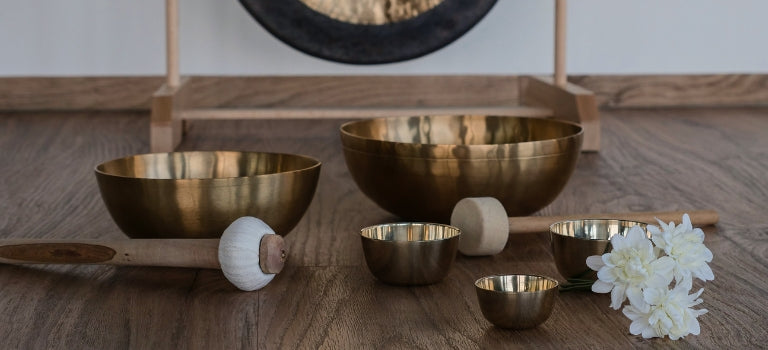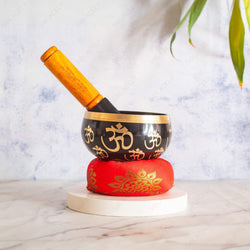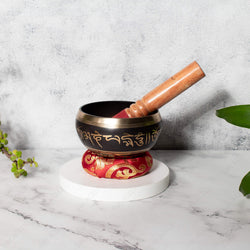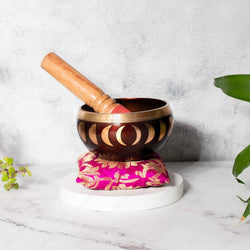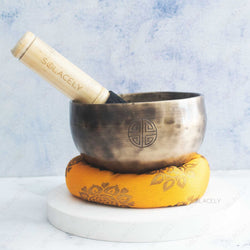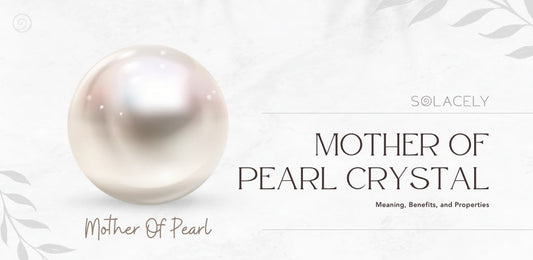The World of Sound Therapy
In alternative healing practices, sound therapy has become a powerful tool for promoting relaxation, stress reduction, and overall well-being. This therapeutic approach utilizes the vibrational properties of sound to restore balance and harmony within the body and mind. One instrument that has been extensively used in sound therapy is the singing bowl.
Sound Therapy
Sound therapy, also known as sound healing or vibrational therapy, is a modality that harnesses the power of sound to promote healing and well-being. It is based on the belief that everything in the universe is in constant vibration, including our bodies. By introducing specific frequencies and vibrations, sound therapy aims to restore harmony and balance to the body's energetic systems.
The Power of Vibrational Healing
The concept of vibrational healing is rooted in the understanding that specific frequencies can profoundly impact our physical, emotional, and spiritual well-being. Sound waves travel through our body, influencing our cells, tissues, and energy centers. When exposed to specific frequencies, our body's natural healing mechanisms can be activated, promoting relaxation, reducing stress, and supporting overall health.
Singing Bowls: An Ancient Instrument
Singing bowls have a rich history, dating back centuries. Originating from various cultures such as Tibet, Nepal, and India, these bowls are crafted from metal alloys and produce a complex and soothing sound when struck or rubbed with a mallet. The vibrations produced by the singing bowl resonate throughout the body, creating a calming and meditative experience.
Singing bowls are often used in meditation, sound baths, and energy healing sessions. Their unique harmonics and frequencies can help induce deep relaxation, allowing individuals to access a heightened sense of awareness and inner peace. Singing bowls have become increasingly popular in contemporary wellness practices due to their ability to promote relaxation, reduce stress, and enhance overall well-being.
In the following sections, we will explore the origins of singing bowls, how they produce sound, and the different types of singing bowls available. Join us on this journey to uncover the transformative power of the singing bowl in sound therapy. To learn more about singing bowls, visit our article on what is a singing bowl.
Understanding Singing Bowls
To fully appreciate the magic of a singing bowl, it's essential to understand their origins, how they produce sound, and the different types available.
The Origins of Singing Bowls
Singing bowls have a rich history traced back to ancient civilizations in Asia, particularly in the Himalayan region. These bowls were traditionally used in religious rituals, meditation, and healing ceremonies. The exact origins of singing bowls remain somewhat mysterious, but they are believed to have originated in Tibet and Nepal.
These sacred instruments were highly valued for their ability to produce harmonious and resonant sounds that were thought to have spiritual and healing properties. Over time, singing bowls have gained popularity beyond their cultural origins and are now cherished by individuals worldwide for their therapeutic benefits.
How Singing Bowls Produce Sound
Singing bowls produce sound through a unique process known as resonance. When the bowl's rim is struck gently or rubbed with a mallet, friction is created, causing the bowl to vibrate. These vibrations produce complex tones and harmonics, making a soothing and melodic sound.
The shape, size, and materials used in the construction of singing bowls play a significant role in the quality and characteristics of the sound produced. The vibrations created by the bowl resonate in the air and within the body, making a deep sense of relaxation and harmony.
Types of Singing Bowls
Several types of singing bowls are available, each with unique characteristics and sound qualities. The two most commonly known types are Tibetan and crystal singing bowls.
Tibetan singing bowls, also known as Himalayan singing bowls, are made from a combination of metals such as copper, tin, and silver. These bowls are handcrafted using traditional techniques passed down through generations. Tibetan singing bowls are known for their warm, deep, and rich tones, varying depending on the metal composition and craftsmanship.
Crystal singing bowls are made from pure quartz crystal. These bowls produce a clear, resonant sound often described as ethereal and refined. Crystal singing bowls are available in various sizes and notes, each corresponding to a specific chakra or energy center within the body.
It's important to note that other types of singing bowls are available, such as bronze and aluminum, each offering their distinct sound qualities. Exploring the different kinds of singing bowls can help you find one that resonates with you and your specific intentions. Understanding the origins, sound production, and types of singing bowls provides a deeper appreciation for these magical instruments. Whether you choose a Tibetan singing bowl or a crystal singing bowl, these instruments' transformative and healing power can be harnessed through practices like singing bowl meditation and sound therapy.
Using a Singing Bowl
To fully experience the therapeutic benefits of a singing bowl, it's essential to know how to use it properly. This section will guide you through preparing for a session, holding and playing the singing bowl, and various techniques for creating resonance.
Preparing for a Session
Before beginning a singing bowl session, finding a quiet and calm space where you can fully relax is essential. Here are some steps to help you prepare:
- Set the intention: Start by setting a clear choice for your session. Whether it is relaxation, meditation, or healing, having a specific focus will enhance the effectiveness of the experience.
- Choose the suitable bowl: Select a singing bowl that resonates with you. Various types of singing bowls are available, including Tibetan and crystal singing bowls. Each class produces a unique sound and vibration, so choose one that aligns with your preferences and intentions.
- Find a comfortable position: Sit in a comfortable position with your back straight and relaxed. You can sit on the floor with crossed legs or on a chair. The goal is maintaining a posture that allows for deep breathing and relaxation.
- Clear the space: Ensure the room is free from distractions, clutter, and noise. Dimming the lights or lighting candles can create a soothing ambiance for your session.
Holding and Playing the Singing Bowl
To produce the resonating sound of a singing bowl, follow these steps:
-
Hold the bowl: Place the singing bowl on the palm of your non-dominant hand. Allow your fingertips to lightly touch the sides of the bowl lightly, ensuring a stable grip. - Prepare the mallet: Hold the mallet (the striker) in your dominant hand. Make sure your grip is comfortable and relaxed.
- Strike the bowl: Gently tap the side of the bowl with the mallet to initiate the sound. Allow the sound to ring out, and listen to the vibration as it fades away.
- Create resonance: To create a continuous sound, begin rubbing the bowl's rim with the mallet in a circular motion. Apply gentle and consistent pressure as you move around the perimeter. This friction will produce a sustained sound and vibration.
Techniques for Creating Resonance
Experiment with different techniques to create a variety of sounds and vibrations from the singing bowl:
- Striking: Besides tapping the bowl, try attacking the side of the bowl with the mallet to produce a sharper and more intense sound.
- Singing: While creating resonance by rubbing the bowl's rim, you can gently press the mallet against the edge to produce a singing or humming sound. This technique requires practice to find the correct pressure and speed.
- Overtones: By adjusting the pressure and speed of the mallet, you can coax out different overtones and harmonics from the bowl. Explore the various sounds and vibrations that arise as you change your technique.
Remember, the key to using a singing bowl effectively is to approach it with an open mind and a relaxed state of being. Experiment with different techniques and allow yourself to immerse in the experience fully. With practice, you will discover how a singing bowl can enhance your well-being and promote inner harmony.
Exploring the Benefits
Using a singing bowl as a tool for sound therapy offers a range of benefits that can enhance overall well-being. Whether you're seeking relaxation, mindfulness, or a way to balance your energies, the enchanting sounds of a singing bowl can provide a profound and transformative experience.
Relaxation and Stress Reduction
One of the primary benefits of using a singing bowl is its ability to induce deep relaxation and reduce stress. As the soothing tones of the bowl resonate through the air, they create a calming effect that can help to quiet a busy mind and release tension from the body. The rhythmic vibrations produced by the singing bowl harmonize the nervous system, promoting a sense of calm and tranquility.
Through regular use, individuals often find that listening to and experiencing the vibrations of a singing bowl helps to alleviate anxiety, improve sleep quality, and restore a sense of inner peace. The gentle and melodic sounds of the bowl can transport you to a state of deep relaxation and provide a much-needed respite from the demands of daily life.
Meditation and Mindfulness
Singing bowls have been used for centuries to enhance meditation and mindfulness practices. The resonant tones produced by the bowl can serve as a focal point, guiding the mind into a state of present-moment awareness. By directing your attention to the sound and vibrations, you can cultivate a sense of mindfulness and deepen your meditation practice.
During meditation, the sound of the singing bowl can act as an anchor, helping to quiet distracting thoughts and bring your focus back to the present. The sustained tones of the bowl provide a steady and grounding presence, allowing you to connect with your breath, body, and the present moment. Many practitioners find that the use of a singing bowl enhances their ability to achieve a state of deep relaxation and heightened awareness.
Sound Healing and Balancing Energies
Singing bowls are often used for sound healing, which involves using sound frequencies to promote physical, emotional, and energetic healing. The singing bowl's vibrations can help restore balance and harmony within the body, mind, and spirit.
The unique tones and frequencies emitted by different types of singing bowls have the potential to resonate with specific energy centers, or chakras, within the body. By placing the singing bowl on or near the body and playing it, the vibrations can help to clear energetic blockages, release stagnant energy, and promote the flow of vital life force energy.
Through sound healing with a singing bowl, individuals may experience a sense of rejuvenation, increased vitality, and a greater sense of overall well-being. It's important to note that while singing bowls can be a powerful tool for self-healing, they should not replace professional medical or psychological treatment.
By exploring the benefits of using a singing bowl for relaxation, meditation, and sound healing, you can harness the transformative power of sound in your journey of self-discovery and well-being. Whether you choose to incorporate a singing bowl into your practice or seek out group sessions such as sound baths, the enchanting resonance of the singing bowl can open up a world of possibilities for inner exploration and growth.
Incorporating Singing Bowls in Your Practice
Once familiarize yourself with the art of using a singing bowl, you can explore various ways to incorporate it into your healing practice or personal spiritual journey. Here are three popular methods for utilizing singing bowls: sound baths and group sessions, integrating singing bowls with other modalities, and caring for your singing bowl.
Sound Baths and Group Sessions
Sound baths and group sessions offer a collective experience of proper healing and relaxation. During a sound bath, participants lie down or sit comfortably while the good healer plays multiple singing bowls, creating a mesmerizing soundscape. The vibrations and harmonics produced by the bowls envelop the participants, inducing a deep state of relaxation and promoting overall well-being.
Group sessions provide an opportunity to harness the collective energy of the participants, creating a robust healing environment. The resonant frequencies of the singing bowls can help release stagnant energy, balance chakras, and promote a sense of unity and connection.
Integrating Singing Bowls with Other Modalities
Singing bowls can be seamlessly integrated with other healing modalities to enhance their effects. Whether you practice yoga, meditation, Reiki, or massage therapy, incorporating the soothing sounds of a singing bowl can deepen the healing experience.
For example, playing a singing bowl at the beginning and end of a meditation session can help center the mind and create a sacred space. When combined with Reiki, the vibrations of the singing bowl can amplify the flow of energy and support the healing process. Similarly, incorporating singing bowls into massage therapy can promote relaxation, release tension, and facilitate energetic balance.
Experiment with different combinations and techniques to discover how singing bowls can complement your healing practices and elevate their impact.
Caring for Your Singing Bowl
Proper care is essential to ensure the longevity and optimal performance of your singing bowl. Here are a few tips to help you maintain your singing bowl:
- Cleaning: After each use, gently clean your singing bowl with a soft cloth to remove dust or residue. Avoid harsh chemicals or abrasive materials that could damage the bowl's surface.
- Storage: Store your singing bowl in a safe and secure place, preferably in a soft cloth bag or a cushioned case to protect it from accidental bumps or falls.
- Handling: When handling your singing bowl, use both hands to support the bowl from the bottom. This helps prevent any strain on the bowl and reduces the risk of dropping it.
- Avoid Extreme Temperatures: Keep your singing bowl away from extreme temperatures and direct sunlight, as these can cause the bowl to expand or contract, potentially leading to damage.
Remember, each singing bowl is unique, and its care may vary depending on the material and craftsmanship. Refer to the manufacturer's instructions or consult a reputable source for specific care guidelines for your singing bowl.
By incorporating singing bowls into your practice and caring for them properly, you can continue exploring the magic of resonance and harness their profound benefits.




